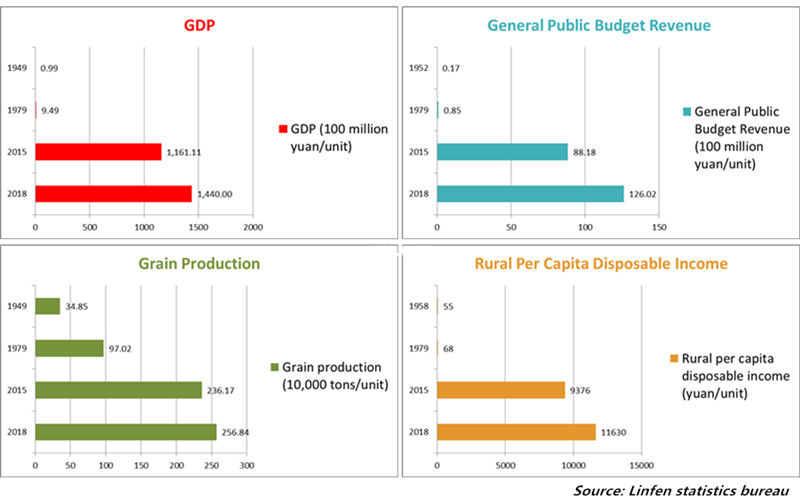Linfen reaps harvest of 7 decades of development
Updated: 2019-09-19

A figure for economic statistics of Linfen city [Photo/chinadaily.com.cn]
Linfen city -- in southwest of Shanxi province -- has made historic achievements in a range of fields over the course of 70 years of development, according to local officials.
The city's regional GDP has grown to 144 billion yuan ($20.31 billion) in 2018 from less than 100 million yuan when the People's Republic of China was founded in 1949.
Its per capita GDP has increased from 72 yuan in 1949 to 32,000 yuan in 2018 and total fiscal revenue has increased from 9 million yuan to 25.83 billion yuan over the same period.
Linfen has been furthering opening up by participating in the development of the Belt and Road Initiative, as well as the Beijing-Tianjin-Hebei region's coordinated development. The city's exports totaled 1.572 billion yuan in 2018, a huge year-on-year increase of 42.05 percent.
It has strengthened communications and cooperation with cities like Anuradhapura in Sri Lanka and Duisburg in Germany.
Large investment promotions of Linfen city have been organized annually in Beijing, Shanghai and Hangzhou. The production line of the first phase of the China-South Korea International Cooperation Industrial Park in the city will soon start operations.
Officials said Linfen has been transforming and upgrading its traditional industries and boosting its emerging industries for years.
It has been cutting overcapacity in the coal industry, with 10.65 million tons of annual coal production capacity having been reduced to date -- and advanced coal production capacity now accounting for 56 percent of the total.
Emerging industries such as equipment manufacturing, new energy, new materials, big data, trade logistics and e-commerce have sprung up.
Linfen has been building provincial demonstration bases for transportation and logistics, precision casting and new energy vehicles. Its manufacturing, strategic emerging industries and high-tech industries account for more than 30 percent of the industrial added value total of the city.
Linfen is also encouraging the development of private companies. Last year, the private sector realized added value of 82.4 billion yuan, accounting for 57.2 percent of GDP.
Meanwhile, the city has been supporting scientific and technological innovation -- with four academician workstations built and 2,460 small and micro-sized enterprises incubated.
Tourism has become a strategic pillar industry of Linfen.
The city has also been promoting modern agriculture a cultural tourism comprehensive development project along the Yellow River, with 11 related projects under construction.
Last year, Hongtong Dahuaishu Ancestor Memorial Garden was rated as national 5A tourist attraction -- the first in Linfen city -- marking a breakthrough in the city's tourism development.
As for its agricultural modernization, Linfen has built five provincial-level organic dry farming demonstration areas -- and accelerated the construction of national modern agricultural industrial parks, with local Quwo county listed as a national modern agricultural demonstration zone.
Officials said that it has carried out upgrading projects in fruit, traditional Chinese medicine, vegetables and grains -- with apples from Jixian county and crisp pears from Xixian county now famous around the country.
They added that more support for leading enterprises in farm produce processing has been given.
The city has chosen six counties, 30 towns and 100 villages as pilot areas for implementing the rural revitalization strategy.
The first rural revitalization institute of Shanxi province has been established in local Daning county. To improve the rural living environment, the city has carried out projects in more than 600 villages.
Officials said Linfen has always been committed to improving the living standards of its residents, with over 80 percent of spending from the general public budget having gone in civil affairs for years.
Many new projects benefiting locals -- such as construction of schools, hospitals and museums -- have been completed and put into operation. The population living under the poverty line in the city declined to 22,000 in 2018 from 237,000 in 2016.
Eight major projects to prevent and control air, water and soil pollution are ongoing. In addition, the city's forest coverage rate has now reached 31.4 percent owing to decades of afforestation, officials added.

